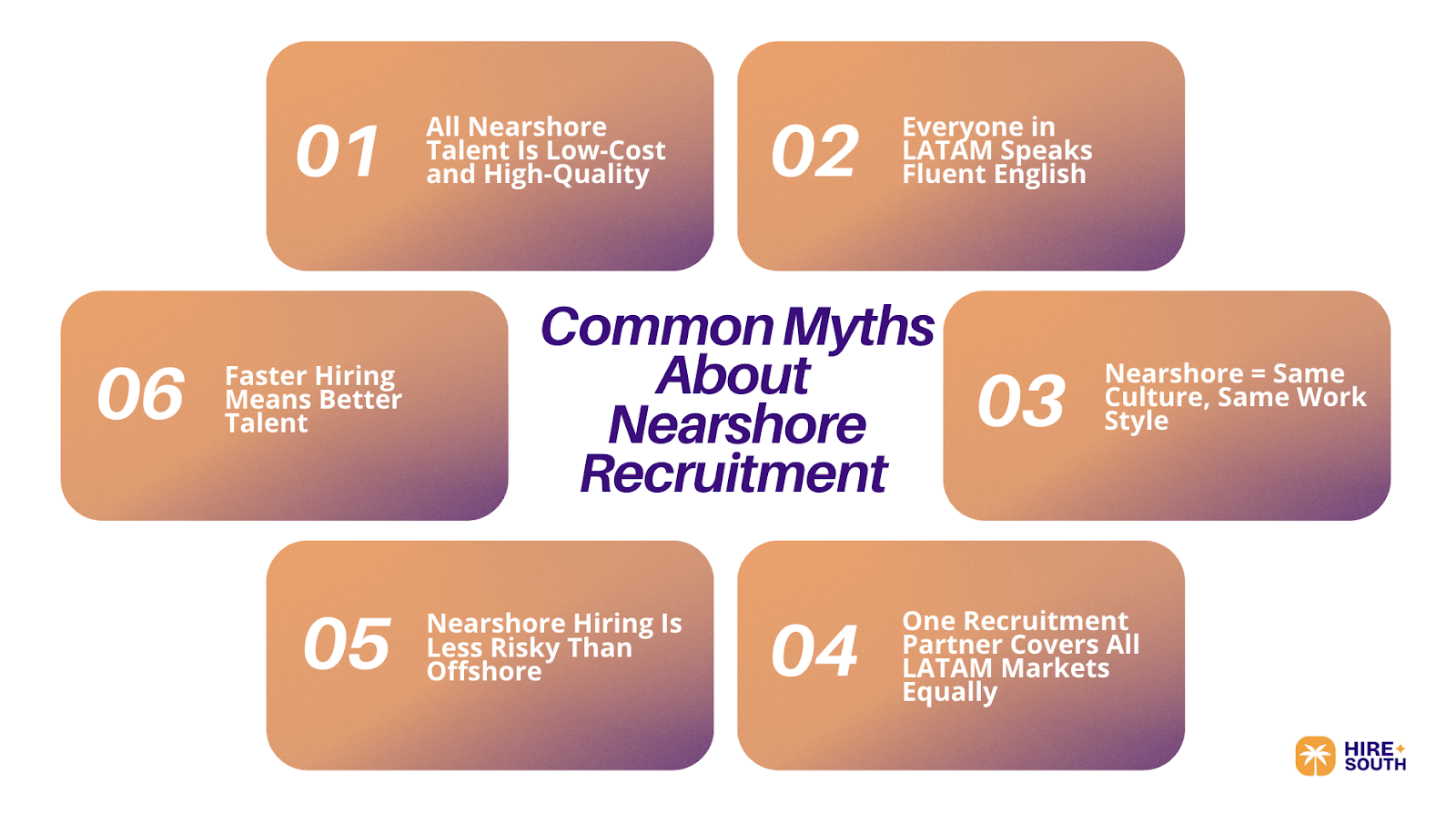Outsourcing to Latin America isn’t news, but it’s evolving fast. From Brazil’s booming tech scene to Colombia’s rapidly growing customer service base, LATAM has long captured serious attention. The region’s talent pool is deep, costs are competitive, and time zone alignment with the US makes collaboration easier.
But here’s the catch: not all recruitment companies are as transparent as they seem. Many overlook critical hiring nuances, cut corners in candidate vetting, or hide fees in fine print. According to Statista, the Latin American outsourcing market is projected to exceed $21 billion by 2027. Let’s face it: that kind of growth comes with noise, some of it misleading.
This article breaks down what some staffing agencies won’t tell you, what to look for in a real recruitment partner, and how to avoid costly mistakes. By the end of it, you’ll know the top outsourcing trends, agency red flags, and smart strategies to build resilient teams across LATAM. Whether you're hiring tech talent, executive support, or contract developers, this guide helps you move smarter, not just faster.
What Recruitment Companies in LATAM Consider ‘Top Talent’
Recruitment companies in Latin America often define "top talent" by a specific mix of technical skills, English proficiency, soft skills, and prior experience with international clients. But the criteria vary by agency and by country. Understanding what their version of top talent looks like helps you decide if their standards match your expectations.
Technical Skills Are Priority One.
In most LATAM recruitment pipelines, hard skills come first. Agencies often look for professionals with fluency in frameworks like React, Node.js, Python, or Java, especially in software development roles.
Many agencies also prioritize developers with experience in Agile or Scrum environments. According to CodinGame’s 2023 survey, LATAM developers rank among the top 5 globally in terms of problem-solving skills.
English Proficiency Matters More Than You Think.
Top recruitment agencies in LATAM heavily emphasize English proficiency, especially when staffing for U.S.-based companies. Many use CEFR benchmarks, often requiring a B2 level or higher.
Countries like Argentina, Chile, and Costa Rica consistently score well in the EF English Proficiency Index, with Argentina ranked 28th globally in 2023. Agencies will often pre-screen candidates using English interviews or automated testing tools to ensure communication won’t be a bottleneck.
Soft Skills Separate Good from Great.
Technical know-how opens the door, but soft skills close the deal. Top-tier LATAM staffing agencies evaluate candidates for adaptability, accountability, and communication style. Cultural compatibility is another common filter, how well someone collaborates in cross-border teams can make or break the hire.
You’ll find many agencies using behavioral assessments or situational judgment tests as part of their selection process. The goal is to filter out talent that performs well under pressure and communicates clearly with distributed teams.
Global Client Experience Gives Candidates an Edge.
If a candidate has worked with North American or European companies before, they jump to the top of the list. Recruiters know global exposure often means better project documentation, familiarity with tools like Asana, and smoother onboarding.
This is especially true in tech. A 2024 LinkedIn Talent Report showed that 72% of LATAM recruiters prefer candidates with remote experience supporting foreign clients. It reduces risk and increases time-to-productivity.
Education and Local Reputation Still Play a Role.
Degrees from top universities in LATAM, like the University of São Paulo, Pontificia Universidad Católica de Chile, or Tecnológico de Monterrey, carry weight. Recruitment companies often use university pedigree as a quality proxy, especially for junior roles.
But experience usually outweighs formal education by the time candidates reach mid- or senior-level positions. That’s where proven portfolios, GitHub contributions, or public endorsements on LinkedIn can shift the conversation.
Time Zone Fit and Availability Are Final Filters.
Many LATAM agencies advertise talent that can overlap at least 4 to 6 hours with U.S. time zones. That’s non-negotiable for most clients, especially in agile teams. Some agencies will even exclude top-tier candidates if their work hours aren’t flexible enough to align with EST or PST.
Agencies will also prioritize candidates who are immediately available or have shorter notice periods. It’s one of the key reasons companies outsource, to avoid waiting 30 to 60 days for someone to onboard.
What Top Recruitment Companies Don’t Always Share
Not every recruitment agency tells the full story. Even the most reputable firms in Latin America may leave out key details that directly impact your hiring decisions. Understanding what’s often left unsaid can help you avoid budget overruns, poor-fit hires, and longer onboarding cycles.
1. Candidate Turnover Data Is Rarely Disclosed:
One of the most overlooked metrics is candidate retention. Many agencies avoid sharing how often their placements leave within the first 90 days. This is critical, especially in tech roles where early turnover leads to project delays and sunk onboarding costs.
According to Gallup, voluntary turnover among remote workers can reach up to 20% annually when cultural fit isn’t properly assessed. Most recruitment companies don’t publish these stats unless asked directly, and even then, the data might not be audited.
2. Screening Standards Vary Widely:
Recruiters often claim to offer “pre-vetted” talent, but the vetting process can be shallow. Some rely heavily on LinkedIn profiles and basic coding assessments, skipping deeper behavioral interviews or language fluency checks.
If an agency doesn’t clearly define its screening process, including who interviews candidates and what tools they use, you’re left guessing. A recent Capterra survey found that 42% of companies switched recruitment vendors because screening didn’t meet expectations.
3. You Might Be Paying for Junior Talent at Senior Rates:
Title inflation is a common issue across outsourcing markets. A candidate labeled as a "senior developer" might only have three years of experience, with no mentorship or architecture background.
Top agencies sometimes pad resumes or emphasize tools over real-world experience. Without clear benchmarking across titles, you could easily overpay. Always ask for years of experience and project scope to verify seniority.
4. Bench Candidates May Be Prioritized Over Better Fits:
Some agencies push “bench” talent, candidates they already have under contract—before exploring the full market. This helps them shorten time-to-fill metrics and increase profit margins, but it doesn’t always serve your team’s best interest.
A 2023 Talent.com study reported that 61% of clients who hired quickly through agencies had to rehire within six months due to skill misalignment. Quick isn’t always better.
5. Hidden Fees and Markups Can Inflate Costs:
Most recruitment firms advertise their markup as a flat percentage. However, additional fees, such as onboarding support, contractor insurance, or early termination clauses, can increase the final cost.
It’s common to see markups between 30% and 50%, depending on contract terms. Yet agencies rarely provide a full breakdown unless pressed. Ask for itemized cost structures to avoid surprises.
6. Local Labor Law Gaps Aren’t Always Flagged:
Recruitment companies may not fully brief you on country-specific employment risks. Labor laws in Brazil, for example, are vastly different from those in Mexico or Colombia. Some agencies limit their liability by placing the burden of compliance on the client.
If you’re hiring contractors, make sure your agency explains tax obligations, severance requirements, and contract classifications. The International Labour Organization reports that misclassified workers now account for 15% of all employment disputes in Latin America.
The Most Common Myths About Nearshore Recruitment

Misconceptions about nearshore recruitment can lead to poor vendor choices, unrealistic expectations, and missed opportunities. The LATAM outsourcing market is full of potential, but separating fact from fiction is critical if you want long-term value.
All Nearshore Talent Is Low-Cost and High-Quality:
While nearshore hiring is more cost-effective than domestic recruitment, not all talent is priced equally or delivers the same results. Rates vary significantly by country, seniority, and demand.
For example, a senior developer in Argentina may cost 30–40% less than a U.S. equivalent, but that same role in Costa Rica may only save you 15%. According to Accelerance’s 2024 Global Software Outsourcing Report, hourly rates for senior engineers in LATAM range from $45 to $75, depending on the market.
Quality also depends on the screening process, not just geography. Assuming low cost always equals high ROI is a shortcut that often backfires.
Everyone in LATAM Speaks Fluent English:
English proficiency in Latin America is improving, but it’s far from universal. The EF English Proficiency Index ranks countries like Argentina and Chile higher, while others like Brazil and Mexico lag in overall fluency.
Assuming your nearshore team will automatically understand nuanced business communication leads to delays and misalignment. Many top agencies test for this, but not all disclose the results. Always verify language skills directly or through a structured test.
Nearshore = Same Culture, Same Work Style:
Time zone proximity doesn’t mean a seamless cultural match. Work culture in LATAM can differ in areas like conflict resolution, meeting etiquette, and hierarchy. For instance, developers in Colombia may be more deferential to authority, while those in Argentina may challenge decisions more openly.
A Deloitte Global Outsourcing Survey found that cultural compatibility was a top-3 reason for outsourcing failure among U.S. businesses in 2023. Training and onboarding are still essential, nearshore doesn’t mean “plug and play.”
One Recruitment Partner Covers All LATAM Markets Equally:
Recruitment firms often market themselves as regional experts, but few have deep local networks in every major LATAM country. A firm with strong connections in Bogotá might struggle to deliver in Montevideo.
Treat claims of “LATAM-wide reach” with skepticism unless they show clear sourcing pipelines in each country. Ask for candidate volume stats by location or client case studies in multiple markets to validate coverage.
Nearshore Hiring Is Less Risky Than Offshore:
Nearshore recruitment does reduce time zone friction and improves collaboration, but it doesn’t eliminate legal, compliance, or retention risks. Misclassification of contractors, unfamiliar labor laws, or lack of IP protection protocols can still create costly issues.
Data from the International Association of Outsourcing Professionals (IAOP) shows that compliance errors in nearshore setups cost businesses an average of $12,500 per incident. Due diligence is just as important as with any offshore model.
Faster Hiring Means Better Talent:
Many agencies emphasize speed-to-fill as a selling point. While that’s attractive, filling roles too quickly can lead to shallow vetting, especially when relying on bench talent. When quality matters, extra time spent on technical tests, culture fit, and communication ability pays off.
Ready to Get Started with LATAM Outsourcing?
Nearshore recruitment in LATAM offers real advantages, but only when you know what to look for behind the polished sales decks and inflated candidate labels. The truth is, many staffing firms skip key details that impact performance, retention, and budget. With outsourcing across Latin America projected to grow 7.5% annually through 2027, according to Statista, the pressure to hire right the first time has never been higher.
At Hire South, we specialize in helping companies build reliable teams in LATAM with full transparency. Our recruitment process focuses on deep-market sourcing, clear candidate profiling, and measurable quality standards. We don’t rely on generic talent pools or automated vetting, we focus on precision, not speed alone. Whether you're scaling fast or filling one critical role, our regional expertise helps you hire better, not just cheaper. Contact us to schedule a discovery call and learn more!

Ready to Hire LATAM Talent?
Let us do the legwork to find your perfect remote hire in Latin America!



.jpg)
.jpg)


.svg)